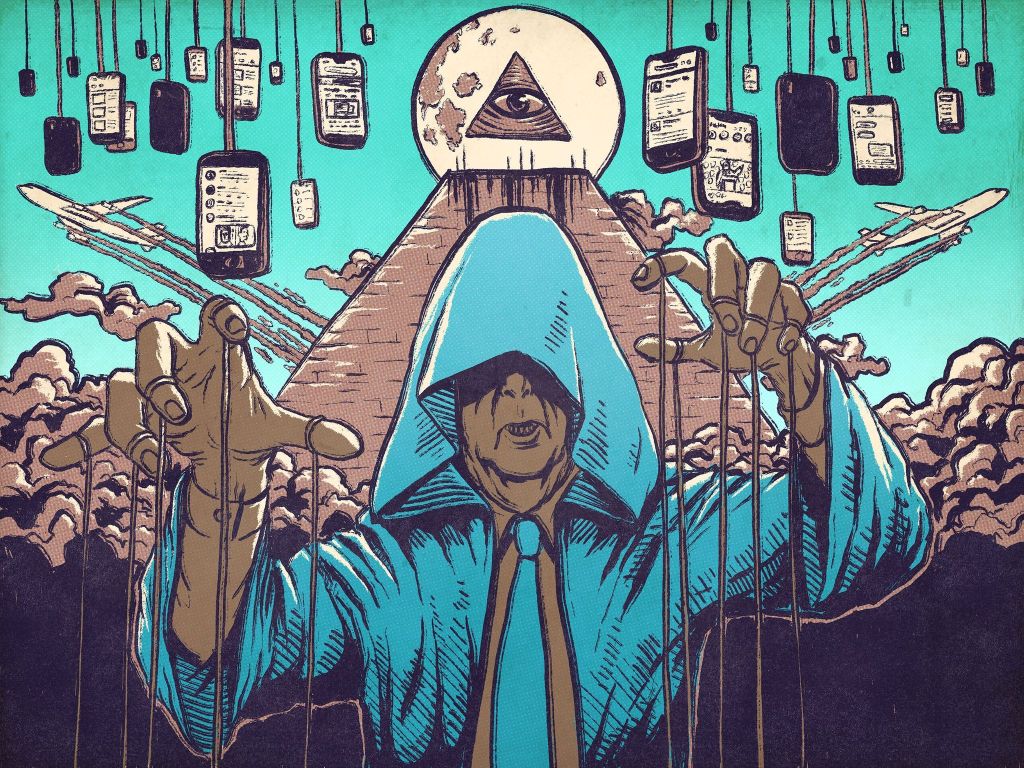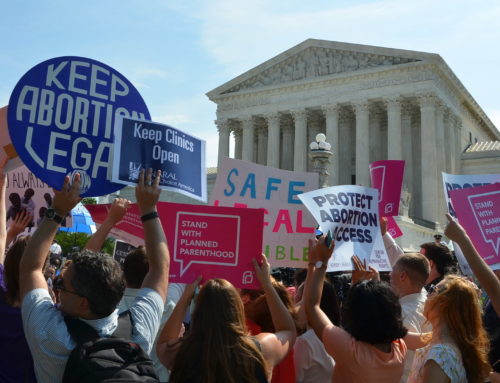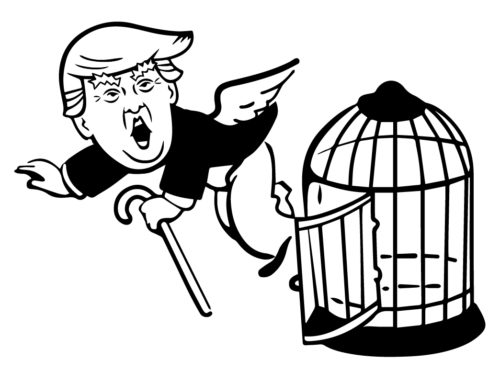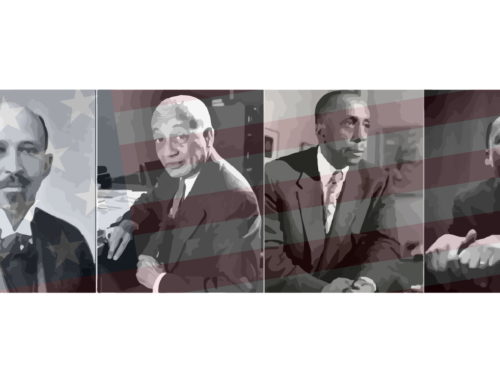By: Jared Millson An essay from 1000-Word Philosophy
NASA faked the first moon landing.[1]
The US government orchestrated the attacks on 9/11.[2]
A cabal of Satan-worshiping pedophiles running a global child sex-trafficking ring is plotting against Donald Trump, who is battling them. [3]
Each of these claims have been denounced as a “conspiracy theory.”[4] But what are conspiracy theories? Should we ever accept one? If so, when? This essay offers initial answers to these questions.[5]
1. Defining Conspiracy Theories
First, what’s a conspiracy?
Conspiracies are actions or plans undertaken by a small group of individuals working in secret to achieve shared goals. These goals need not be sinister: the African National Congress conspired for decades to bring down the apartheid regime in South Africa—a noble aspiration.
Second, what’s a theory?
In general, theories try to explain some set of (alleged) facts or events, usually by identifying their causes. The first two examples above (the moon landing coverage and the 9/11 attacks) attempt to explain these events by making claims about what caused them.[6]
Putting these together yields this definition:
a conspiracy theory is an explanation of some alleged fact or event in terms of the actions undertaken by a small group of individuals working in secret.[7]
2. Common Misunderstandings
Conspiracy theories are often assumed to be inherently irrational or false by definition.[8] But since some accusations of conspiracy have merit, a definition should not assume that conspiracy theories must be problematic.[9] Our proposed definition reflects this and corrects this common misunderstanding.
Indeed, most people accept some conspiracy theories—e.g., Watergate or the claim that the 9/11 attacks were perpetrated by al-Qaeda. In fact, if you’ve told someone about a recent surprise party you attended, then you’ve explained an event by reference to a small group of individuals working in secret, and so you’ve offered a conspiracy theory!
Conspiracy theories need not contradict any “official story” or explanation of events that most people accept.[10] If they did, then a conspiracy theory would cease to be one, e.g., when official sources give conflicting stories, when there simply is no official account, or when the conspiracy theory is adopted by officials.[11]
3. Evaluating Conspiracy Theories
So conspiracy theories are sometimes true; they are sometimes reasonable to accept. But when?[12]
Conspiracy theories claim the existence of a conspiracy. Conspirators disclosing or “leaking” information about their activities would be good evidence for a conspiracy theory. But few people admit to being directly involved in conspiracies, so conspiracy theories typically lack this support.[13]
Some claim that successful conspiracies won’t have leaks.[14] But the absence of such evidence does undermine a theory when efforts to find it fail. And the more ambitious a conspiracy, the less likely its activities are to remain secret. It is hard to get people to work together on long-term, complex projects—much less in secret.
Conspiracy theories often claim to explain data that contradicts or is left out by the official story. But they rarely end up explaining more data than their rivals, since they tend to have their own “errant data” that they cannot accommodate:[15] e.g., conspiracy theories about 9/11 usually cannot explain why there is a video of Osama Bin Laden claiming responsibility for the attacks.[16] So conspiracy theories often do not explain more data.[17]
Since they appeal to one cause (i.e., the conspiracy’s goal) rather than to many, conspiracy theories may seem simpler than their rivals—e.g., when an international free-trade agreement is explained by leaders’ secret desire for world government, rather than by many competing national interests.
However, conspiracy theories often add causes—conspiratorial ones—to explanations offered by their non-conspiratorial rivals: e.g., the “Pizzagate” conspiracy theory[18] claimed that kids were at a pizza shop because of a child-trafficking ring’s activities. This assumes that kids were there for pizza and a malicious cartel’s actions. So this conspiracy theory, like many others, is not simpler.[19]
Some see the problems not in conspiracy theories themselves but with their advocates who rarely make novel predictions and tend to accommodate failed predictions by making ad hoc changes to their theory rather than by abandoning it.[20] Some inflate the scope of a conspiracy to save their theory:[21] e.g., when a newspaper’s articles contradict a conspiracy theory, they conclude that the newspaper’s staff is in on the conspiracy too.[22]
Some critics charge conspiracy theorists with failing to properly defer to experts, resulting in theories that contradict expert testimony.[23] Conspiracy theorists often justify their mistrust by claiming that experts are themselves part of the conspiracy or have been duped by it.[24] But this is yet another way to inflate the scope of a conspiracy, which makes its existence less likely.
Other critics claim that distrust of experts is a harmful effect, rather than a cause, of conspiracy theorizing. Since much of what we know comes from experts[25] and public institutions (e.g., the government, the press, academia, and professional organizations), accepting conspiracy theories deprives us of vital sources of knowledge.[26] Of course, only those theories that posit conspiracies with pervasive influence on our public institutions require such widespread skepticism.[27]
So, while conspiracy theories aren’t inherently irrational or false, few offer better explanations than their rivals.
4. Why Conspiracy Theories?
Many people, nonetheless, find conspiracy theories appealing. By urging us to “follow the breadcrumbs”[28] and to “think for ourselves,”[29] these theories promise to make a complicated world intelligible to those without specialized training or expert knowledge. By claiming that a small group of evildoers are behind tragic events, they offer simple solutions to complex problems.[30]
Whatever their appeal, we should approach conspiracy theories the way we would any theory—i.e., by comparing their merits to their rivals’. Far-reaching conspiracies are rarely successful, so the more plausible conspiracy theories might be those that try to explain a smaller range of events by appealing to a conspiracy with limited goals.[31] These theories also shouldn’t challenge the judgment of experts without providing adequate evidence of their unreliability.
Will any of today’s influential conspiracy theories meet these demands? Probably not.[32]
Notes
[1] See Exposed: Apollo 11 Moon Landing Conspiracy Theories, (2019, June 28). Some versions of this theory even claim that the famed director Stanley Kubrick helped to film the fake moon landing and that his film The Shining is a cryptic “confession” (Lamb, 2010).
[2] There are various versions of this theory. For a consideration of some, see Was 9/11 an Inside Job? (2016, September 8).
[3] The QAnon conspiracy theory is arguably among the most influential conspiracy theories in the history of US politics. But it is by no means the first. Aside from the well-supported theories regarding the Watergate Hotel break-in (Perlstein, 2020) and the Iran-Contra-Affair (“The Iran-Contra Affair,” 2020), a version of the Illuminati conspiracy theory played an important role in early American politics (Fea, 2020). For an overview of the QAnon theory, See What is QAnon? How the Conspiracy Theory Gained Traction in the 2020 Campaign, (2020, August 12).
[4] While such claims may have increased with the rise of social media, the term “conspiracy theory” has been with us for some time. The term seems to have first appeared in a New York Times article in 1863 (Caulfield, 2018).
[5] For a brief overview of the philosophical thinking about conspiracy theories, see Pauly (retrieved 2020). For more extensive treatments, see Dentith (2014), Coady (2006) and Uscinski (2018). The first philosopher to address conspiracy theories explicitly and at length was Karl Popper (1966; 1972).
[6] Muirhead and Rosenblum (2019) claim that the recent wave of conspiracy theories, what they call the new conspiracism, are not really “theories” at all, since they don’t offer explanations or claims about causes: they are mere insinuations of a conspiracy. Clarke (2002; 2007) also contends that some conspiracy theories are not sufficiently developed to count as theories.
[7] This is similar to the definition proposed by Dentith (2014; 2018a) and Keeley (1999). The definition has some open-ended elements.
How small must a group be to count as a conspiracy? Qualifying as a member of a conspiracy often depends on how much someone knows about the group’s plans and what level of influence they have over them.
What counts as working in secret? To act in secret there must be someone who you’re trying to keep in the dark. But secrecy can’t demand that no one knows about your plans, since you do. Generally, conspirators act in secret in the sense that they seek to minimize public awareness of their plans. See Mandik (2007) and Dentith (2014) for more on these issues.
[8] As Keeley (1999) notes, treating conspiracy theories as epistemically suspect by definition is similar to the way Hume defines miracles as running counter to laws of nature and hence, by definition, irrational to believe.
[9] There are other reasons to prefer a neutral definition. Calling something a conspiracy theory seems to be a claim about what the theory is about, not about the presence or absence of evidence to support it. Likewise, having a neutral definition lets us separate the task of evaluating a theory’s epistemic merits from that of deciding what to call it.
The debate about the proper definition of “conspiracy theory” reflects a divide in the philosophical literature on the subject between those who believe that conspiracy theories are inherently epistemically suspect—a.k.a. generalists—and those who think that each conspiracy theory should be assessed by its own merits—a.k.a. particularists. See Buenting, & Taylor (2010), Dentith (2014; 2018a), Coady (2006), Pigden (2006; 2016). In an effort to accommodate the pejorative connotation of the term, some have offered “conspiracism” as a label for the pathological tendency to believe conspiracy theories independently of their epistemic merits (Dentith, 2014; 2018a).
[10] Coady (2003), however, advocates for a definition that requires a contrast with an official story. For criticisms, see Dentith (2014) and Pigden (2007).
[11] For example, Woodward and Bernstein’s claim—the conspiracy theory that the Nixon administration was behind the Watergate break-in—initially contradicted the administration’s own account but was later accepted as the official story. It seems odd to say that Woodward and Bernstein’s story ceased to be a conspiracy theory once it was endorsed by officials, since none of its claims changed. So theories can be, or become, widely accepted yet still be conspiracy theories. For more on the Watergate scandal, see Perlstein, (2020).
[12] This section considers how conspiracy theories fare against their rivals when compared according to certain “theoretical virtues”—i.e., criteria that scientists use, at least implicitly, to select the best theories from among available options. These theoretical virtues include internal consistency, coherence with other accepted theories, evidential support, simplicity, and unification, among others.
This section addresses the last three. A theory’s evidential support is largely a matter of how well it fits the data. As for simplicity, one theory is simpler than another if it can explain the same data with fewer causes. Conversely, a theory is more unifying than another if it can explain more with the same resources. Some contend that conspiracy theories perform particularly badly when judged by these standards—e.g., Basham (2001) and Räikkä (2009).
[13] Mandik (2007) and Clark (2002) both point to problems with conspiracy theorists’ appeal to conspirators’ mental states (e.g., beliefs, desires, intentions). For Mandik, this appeal, when combined with the claim that conspirators’ avowals are untrustworthy, makes it difficult for conspiracy theories to overcome problems associated with intentional explanations. Clark thinks conspiracy theorists are guilty of the “fundamental attribution error”—i.e., the human tendency to overestimate dispositional factors and underestimate situational factors in explaining the behavior of others. This claim, however, has been challenged by Pigden (2006) and Coady (2003).
[14] Indeed, a lack of evidence for a conspiracy is exactly what we’d expect if there is in fact a conspiracy working to keep its activities a secret. Keeley (2003) concludes from this that unfalsifiability (i.e., the inability to identify a type of evidence that would show the theory to be false) is not a good reason to reject conspiracy theories. Basham (2003) makes a similar claim. Keeley (2003) thinks that absence of evidence may be construed as evidence of absence only when diligent efforts to find evidence, efforts that have succeeded in similar cases, fail.
[15] Keeley (1999) was the first to criticize conspiracy theories for an over-reliance on “errant data” (his term).
[16] Clarke (2002) and Dentith (2019) both point this out in response to Keeley’s criticism regarding “errant data”.
[17] Even when a conspiracy theory does explain or unify more data than its alternatives, this may not make it better. Unifying more data is only advantageous when the data explained is true, and not all data will be. So a theory that explains more eye-witness reports of an event like the 9/11 attacks, need not be better, all things considered, than its competitors, since eye-witness testimony is often compromised by the effects of unconscious bias, faulty memory, and the power of suggestion. This is one of the reasons Keeley (1999) thinks the preoccupation with explaining errant data compromises the evidential support for many conspiracy theories.
[18] For a detailed account of the “Pizzagate” conspiracy theory, see Robb (2017).
[19] Some suggest that just as—all else being equal—we should avoid explaining events with many causes when fewer will do, we should avoid explaining events by appeal to malice when incompetence will do. This rule of thumb is sometimes called Hanlon’s Razor (Hanlon’s Razor, 2020)—a nod to Occam’s Razor, which instructs us to select, all else being equal, explanations with fewer causes over those with many.
[20] This is Clarke’s (2002; 2007) criticism. He claims that conspiracy theories are “degenerating research programmes” in the sense developed by Lakatos (1970). Pigden (2006), however, questions whether there is genuine support for this claim.
[21] We might liken conspiracy theorists to followers of millenarianism who, in the wake of a prophesied “Second Coming” that fails to materialize, find ingenious ways to reinterpret those prophecies as referring to some date further in the future (Barken, 2018).
[22] As the conspiracy expands to include the newspaper’s staff, it can seem less likely that one exists, since larger conspiracies are harder to keep secret and offer more opportunities for investigators to find evidence of their existence. This concern relates to other criticisms regarding how likely conspiracies are in general—i.e., their prior probability. Dentith (2014; 2016) claims that conspiracies, defined neutrally, are historically quite common.
[23] Levy (2007) makes a claim along these lines, arguing that a conspiracy theory that contradicts the judgment of relevant “epistemic authorities” is prima facie unwarranted.
In response to this claim, Dentith (2018b) observes that conspiracy theories often make claims that cut across many different disciplines. For instance, some versions of the “9/11 was an inside job” theory not only make claims that only experts in international politics can confirm—e.g., about the operations of Israeli intelligence services—but also claims that only civil engineers and chemists can assess—e.g., about the way buildings collapse and how insulated steel beams behave under extreme heat.
Consequently, there are no experts or “epistemic authorities” on conspiracy theories per se and hence there is no relevant, accredited community of inquirers, as there is for fields like civil engineering, chemistry, and international politics. Aside from cases like 9/11 in which the government convened a commission of experts to investigate the attacks, there is no single group whose judgment can be appealed to when appraising a conspiracy theory. In the absence of such a community, conspiracy theorists attempt to cobble together what Dentith (2018b) calls “improvised expertise.”
[24] One reason for this impasse is that trust in experts depends upon how likely we think conspiracies are in the first place, i.e., their prior probability. If they are quite common, then there may be good reasons not to trust experts, since the latter are more likely to be part of a conspiracy. See Basham (2001) and Dentith (2016).
[25] See Expertise by Jamie Carlin Watson.
[26] This criticism has been leveled, in different forms, by Keeley (1999) and Levy (2007).
[27] This is Clarke’s (2002) response to Keeley’s (1999) criticism.
[28] This expression, which refers to the trail of breadcrumbs left by Hansel in the classic children’s fairy tale, is what proponents of the QAnon conspiracy theory use to describe their activities. The supposed government insider, Q, leaves clues or “breadcrumbs” in online discussion forum posts—what are known as “Q drops”—that his followers—self-described “bakers”—attempt to decipher. See Schwartz (2018) for more on the QAnon theory and its advocates.
[29] We should remember that deferring to experts is part of what it means to “think for ourselves”. Many philosophers think that we are always entitled to rely on the testimony of experts unless there is a specific reason to doubt their reliability. See Watson (2018, October 25).
[30] Advances in science and technology require an ever-increasing specialization of knowledge and skills that makes it difficult for any one of us to understand how our world works. This broad historical trend may explain, in part, why conspiracy theorizing is gaining popularity.
There are, of course, many more reasons why people find conspiracy theories so compelling, including the thrill of solving puzzles, the desire to be among the “enlightened few,” and the tendency many have to seek out meaningful patterns among unrelated or random things (a.k.a. apophenia). For a game-designer’s take on the appeal of the QAnon conspiracy, see Berkowitz (2020).
[31] Räikkä (2009) offers a helpful distinction among political conspiracy theories according to whether their claims are local (e.g., Watergate), global (e.g., the Iran-Contra Affair), or total (e.g., the Illuminati) in scope. Räikkä claims that conspiracy theories that aim to explain only limited historical phenomena—i.e., local and global ones—tend to be better supported than total ones, which often posit permanent conspiracies (i.e., those that have been around for centuries). It’s interesting to consider whether the QAnon theory, which ostensibly only aims to explain events in US politics, would qualify as local according to this distinction.
[32] For more on the rise of conspiracy theories in social media, including tips on how to spot them, see Ellis (2018).
References
Basham, L. (2001). “Living with the Conspiracy”, The Philosophical Forum, vol. 32, no. 3, pp. 265-280.
Basham, L. (2003). “Malevolent Global Conspiracy”, Journal of Social Philosophy, vol. 34, no. 1, pp. 91-103.
Berkowitz, R. (2020, September 30). “A Game Designer’s Analysis Of QAnon: Playing with Reality,” Medium.
Buenting, J. and J. Taylor (2010). “Conspiracy Theories and Fortuitous Data”, Philosophy of the Social Sciences, vol. 40, no. 4, pp. 567-578.
Caulfield, M. (2018, Dec. 24). “The First Use of the Term ‘Conspiracy Theory’ is Much Earlier — and More Interesting — Than Historians Have Thought.” Hapgood, (retrieved 2020, December 15).
Clarke, S. (2002). “Conspiracy Theories and Conspiracy Theorizing”, Philosophy of the Social Sciences, vol. 32, no. 2, pp. 131-150.
Clarke, S. (2006). “Appealing to the Fundamental Attribution Error: Was it All a Big Mistake?”, in Conspiracy Theories: The Philosophical Debate. Edited by David Coady. Ashgate, pp. 129-132.
Clarke, S. (2007). “Conspiracy Theories and the Internet: Controlled Demolition and Arrested Development”, Episteme, vol. 4, no. 2, pp. 167-180.
Coady, D. (2003). “Conspiracy Theories and Official Stories”, International Journal of Applied Philosophy, vol. 17, no. 2, pp. 197-209.
Coady, D., ed. (2006). Conspiracy Theories: The Philosophical Debate. Ashgate.
Dentith, M. R. X.(2014). The Philosophy of Conspiracy Theories. Palgrave MacMillan.
Dentith, M. R. X. (2016). “When Inferring to a Conspiracy might be the Best Explanation,” Social Epistemology, 30 (5-6): 572-591.
Dentith, M. R. X. (2018a). “The Problem of Conspiracism,” Argumenta 3 (2): 327-343.
Dentith, M. R. X. (2018b). “Expertise and Conspiracy Theories,” Social Epistemology. 32 (3): 196-208.
Ellis, E. G. (2018, October 5). “The WIRED Guide to Online Conspiracy Theories: Everything you need to know about George Soros, Pizzagate, and the Berenstain Bears,” WIRED. (Retrieved 2020, December 15).
Exposed: Apollo 11 Moon Landing Conspiracy Theories [Video]. (2019, June 28) YouTube, uploaded by USA TODAY.
Fea, J. (2020, September 24). “An Illuminati Conspiracy Theory Captured American Imaginations in the Nation’s Earliest Days—And Offers a Lesson for Now,” Time.
Hanlon’s Razor. (2020, November 30) Wikipedia, Wikimedia Foundation. (Retrieved 2020, December 15).
Keeley, B. (1999). “Of Conspiracy Theories”, The Journal of Philosophy. 96 (3): 109-126.
Keeley, B. (2003). “Nobody Expects the Spanish Inquisition! More Thoughts on Conspiracy Theory”, Journal of Social Philosophy, 34 (1): 104-110.
Lakatos, I. (1970). “Falsification and the Methodology of Scientific Research Programmes”, in I. Lakatos and A. Musgrave, editors, Criticism and the Growth of Knowledge. Cambridge University Press, pp. 91-196.
Lamb, R (2010, January 21) “Faked Moon Landings and Kubrick’s ‘The Shining,” Seeker. (Retrieved 2020, December 15).
Mandik, P. (2007). “Shit Happens”, Episteme, vol. 4 no. 2, pp. 205-218.
Muirhead, R. and N. Rosenblum. (2019). A Lot of People are Saying: The New Conspiracism and the Assault on Democracy. Princeton University Press.
Pauly, M. (retrieved 2020, December 15). “Conspiracy Theories,” Internet Encyclopedia of Philosophy.
Perlstein, R. (2020, October 22). “Watergate Scandal,” Encyclopædia Britannica.
Pigden, C. R. (2006). “Complots of Mischief”, in David Coady (ed.), Conspiracy Theories: The Philosophical Debate. Ashgate, pp. 139-166.
Pigden, C.R. (2007). “Conspiracy Theories and the Conventional Wisdom,” Episteme, vol. 4 no. 2, p. 219-232.
Pigden, C.R. (2016). “Are Conspiracy Theorists Epistemically Vicious?”, in Coady, D., Brownlee, K. and Lipper-Rasmussen, K. (eds.), Blackwell Companion to Applied Philosophy, Wiley-Blackwell, Ch. 9.
Popper, K.R. (1966). The Open Society and Its Enemies, vol. 2: The High Tide of Prophecy, 7th edition, Routledge.
Popper, K.R. (1972). Conjectures and Refutations: The Growth of Scientific Knowledge. 2nd edition, Routledge.
Räikkä, J. (2009). “On Political Conspiracy Theories”, Journal of Political Philosophy, vol. 17, no. 2, pp. 185-201.
Robb, A. (2017, November 16). “Pizzagate: Anatomy of a Fake News Scandal,” Rolling Stone.
Schwartz, M. (2018, September 11). “A Trail of ‘Bread Crumbs,’ Leading Conspiracy Theorists Into the Wilderness,” New York Times Magazine.
“The Iran-Contra Affair.” (2020, September 10). Encyclopaedia Britannica (retrieved 2020, December 15).
Uscinski, J.E., ed. (2018). Conspiracy Theories and the People Who Believe Them. Oxford University Press.
Was 9/11 an Inside Job? [Video]. (2016, September 8). YouTube, uploaded by Step Back History.
Watson, J. C. (2018, October 25). “Expertise,” 1000-Word Philosophy: An Introductory Anthology.
What is QAnon? How the Conspiracy Theory Gained Traction in the 2020 Campaign [Video]. (2020, August 12). YouTube, uploaded by PBS NewsHour.
Related Essays
Epistemology, or Theory of Knowledge by Thomas Metcalf
Expertise by Jamie Carlin Watson
Take My Word for It: On Testimony by Spencer Case
Modal Epistemology: Knowledge of Possibility & Necessity by Bob Fischer
Interpretations of Probability by Thomas Metcalf
Karl Popper and Falsificationism by Michael Zerella
Can We Believe in Miracles? by Tomas Bogardus
Jared Millson is an assistant professor in the department of philosophy & religious studies at California State University, Bakersfield. His work engages issues in epistemology, philosophy of language, philosophy of science, and logic. Much of it focuses on the nature of inquiry, the logic of questions and answers, and the study of scientific explanation and representation. www.jamillson.com
Image: “The Pigpen Cipher” by Matthew Phelan, via 1000 Word Philosophy.










Leave A Comment